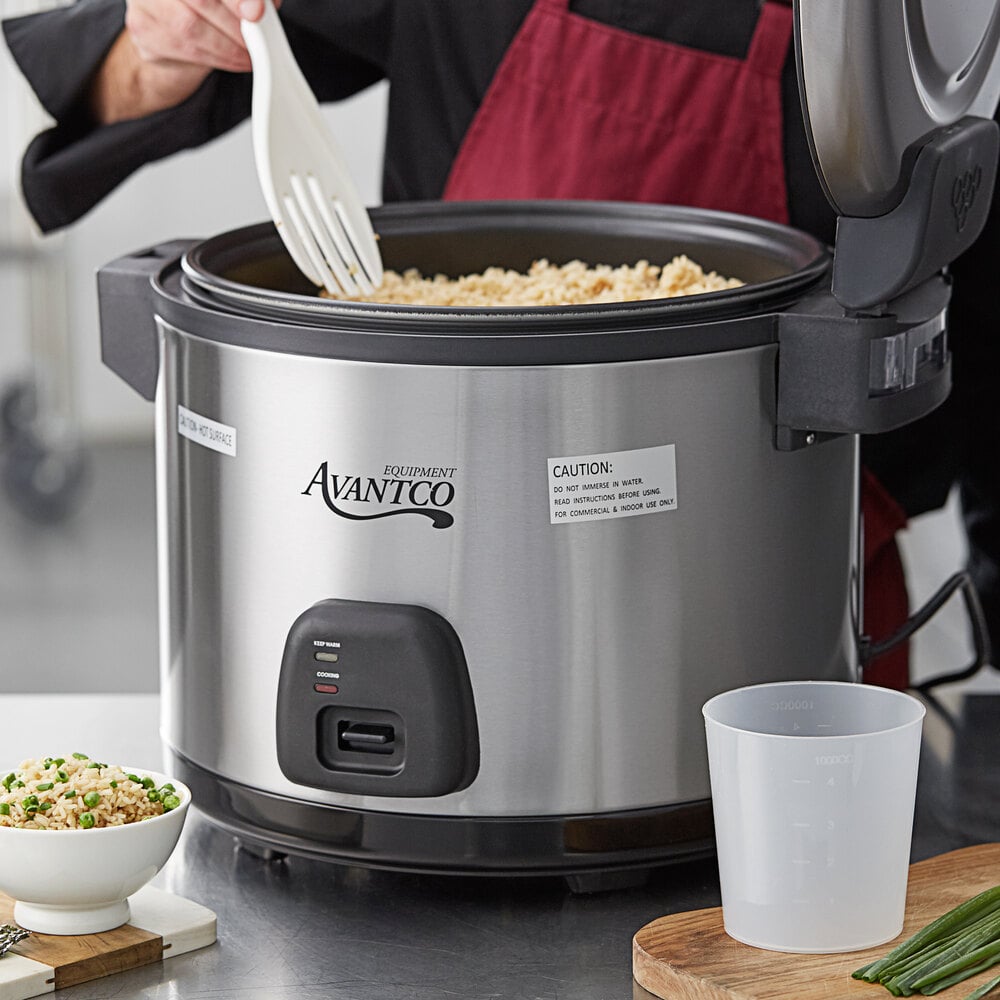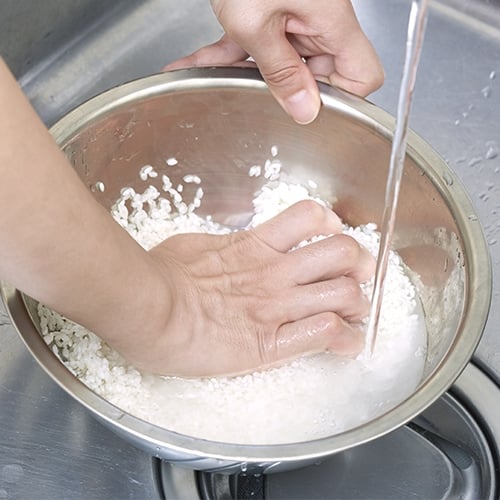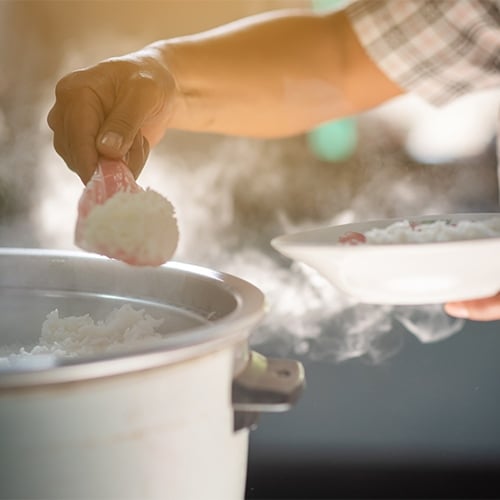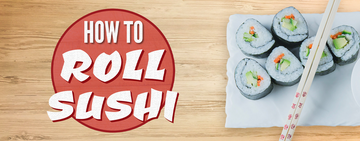
Types of Rice Cookers
If you use a significant quantity of rice in your restaurant's day-to-day operations, there's no tool more important than a rice cooker to add to your arsenal. Commercial rice cookers simplify the rice-making process, ensuring fewer errors and delicious tasting rice every time. Be sure to check out our commercial rice cooker reviews as well!
Shop All Rice Cookers

How Does a Rice Cooker Work?
Standard rice cookers have a heating element and a temperature sensor or thermostat positioned beneath the inner bowl, which is made of metal to conduct and distribute heat evenly. They feature one or more simple control switches to commence the cooking process. Once turned on, the bowl begins to heat up, which in turn begins to transfer the heat to the water in the bowl.
The heat brings the water to a boil and coverts it to steam, at which point the rice begins to absorb the moisture and cook. The machine will automatically set the cook time to the proper amount based upon the amount of rice and water used. Once the rice absorbs all of the water, the temperature will start to rise. Sensing this change, the rice cooker will either automatically shut off or switch to a warming cycle.
How to Choose the Best Rice Cooker
Here are some factors to consider when purchasing a rice cooker for your business.
- What power type do you need? Rice cookers come in either electric or gas options. Which type is best for your business depends on your menu and your kitchen's space and utilities.
- How much rice do you need to cook? Be sure you know the raw rice and cooked rice capacity of your unit before purchasing. If you choose a rice cooker that is too large, you may experience issues with cooking a small batch.
- Are you looking for both cooking and warming capabilities? Rice cookers / warmers have both cook and warm modes to streamline your operation and keep the rice at an ideal serving temperature.
- Do you need it to cook other types of grains? Some units are capable of cooking grits, oatmeal, and noodles, which may be necessary for small footprint kitchens.
Electric vs Gas Rice Cooker
To choose a rice cooker for your operation, consider the quantities of rice you'll need to make throughout a day and the uses of each type.


If you have limited space in your kitchen or you do not have ventilation you can use, electric rice cookers are the best option for you. They are much simpler to operate and maintain, and are ideal when cooking smaller quantities of rice.
- Do not require as much heat to cook the rice, making them an eco-friendly option
- No ventilation required
- Plug-and-play portability and compact design
- Easy for any staff member to use; instant operation
- Requires less maintenance
- Non-traditional, indirect heating
- Less efficient for high-volume operations
- Electricity may be more expensive


Available in natural gas and liquid propane power types, gas rice cookers deliver high heat production that is impractical for small batches. They cook rice by preheating rice grains using a direct flame and then cooking them through with pressure, a process said to result in flavor enhancement. Gas rice cookers are ideal for establishments that cook large quantities of rice each day, such as in sushi bars or Indian restaurants where rice is commonly served with entrees.
- Heats and cooks rice faster
- Preheats and cooks rice using a direct flame; closer to traditional cooking methods
- May result in a sweet, flavorful aftertaste
- More complex operation
- Requires ventilation under a hood
- Fuel components require routine cleaning
Tips to Follow When Using a Rice Cooker
Using a rice cooker is simple and they can make your life much easier if rice is something you need to produce consistently and quickly. Here are some tips to follow to ensure your rice cooker makes fluffy rice every time!

- Rinse your rice before cooking. It's a good idea to rinse most varieties of rice before cooking. Rinse brown rice once and white rice several times using a fine colander or mesh strainer. In general, rinsing your rice:
- Removes any debris present
- Removes surface starch that causes rice to become gummy
- Ensures fluffy, firm grains that retain their independent form
- Reduces the amount of foam to prevent bubbling over

- Use the correct water to rice ratio. A range of factors affect the amount of water different varieties of rice need to cook. Keep the following in mind when preparing:
- Bran content, grain shape, and grain size affect water amounts (i.e., intact outer bran requires slightly more water)
- Read variety-specific package instructions to ensure you're using the correct amount of water
- Note: the standard ratio is 1 1/2 cups of water to 1 cup of rinsed rice.

- Enhance the flavor of your rice. It's not uncommon to add bay leaves, cardamom pods, cinnamon sticks, and other spices directly to your rice cooker to create a rich, aromatic experience. Many people prefer to add a bit of salt, oil, butter, or milk to their rice to enhance the taste as well.
- Let your rice rest after cooking. Your rice cooker may shut off and switch to warming mode, but this does not mean that the rice inside is done cooking. Letting your rice rest for 5-10 minutes after the cooker has shut off ensures that it has time to finish cooking and allows excess moisture to steam out.
- Clean up quickly between batches. Cleaning the inner bowl of rice cookers can be tricky, so it's wise to clean up quickly to save time and be ready for the next batch. Remove any leftover rice and fill the inner pan with hot, soapy water. Give it some time to allow food particles to soften and break up. Then use a non-abrasive sponge or towel to wipe the pan clean.
- Do not peek into the rice cooker. Steam escapes every time you open your rice cooker. Because you're combining rice with the precise amount of water it will need to cook, doing this causes rice to dry out. Keeping track of cook times will help you avoid lifting the lid.
- Do not use metal utensils to serve rice. Metal utensils won't spoil the taste of your rice, but they may damage the non-stick coating of the inner pan used in most rice cookers. Use plastic servingware to prolong the life of your cooker.
Rice Cooker Accessories
Various accessories can help you get the most out of using your rice cooker. Among them are containers used to hold and maintain the quality of cooked rice and specific utensils ideal for serving rice. Check out some of the most important equipment and accessories below.
- Sushi Rice Container: A sushi rice container is fully insulated to keep prepared sushi rice at the right temperature and consistency.
- Colanders: Some colanders are designed with small holes that are ideal for rinsing rice before cooking.
- Rice Warmer: A rice warmer holds cooked rice at the optimal serving temperature without continuing to cook it.
- Rice Paddle: Use a rice paddle to season and serve rice.
- Rice Napkin: Featuring a reusable mesh design, a rice napkin holds rice while it cooks, allowing for easy cleanup and thorough drainage.
- Rice Cup: A rice cup is a traditional Japanese measurement - 1 rice cup equals approximately 3/4 (180 ml) of a standard US cup (240 ml).
Related Resources

Types of Woks
One of the most versatile cooking pans in the world, the simple design of woks originated in China and is now used the world over. The beauty of the wok lies in its round shape, which allows for even heat distribution and efficient cooking. Woks are available in a variety of materials, each with its unique advantages. Discover the two main styles of woks, the materials they come in, and how to use them so you can integrate this essential piece of cookware into your kitchen. Shop All Commercial Woks Use the following links to navigate this guide to woks: What Is a Wok? Cantonese Wok vs Mandarin Wok What Are Woks Made Of? Wok Accessories How to Use a Wok Best Oil for Wok Cooking

How to Roll Sushi
Whether it's raw tuna or deep-fried, tempura-battered shrimp, it seems like everyone has a favorite kind of sushi . This delicious Japanese food tradition, which utilizes ingredients like sushi-grade fish , seaweed, rice, and vegetables, has spread all across the world and is now such a common food trend that you can even pick it up at grocery stores and gas stations. One of the best things about this savory (and sometimes sweet) treat is that despite its small size, it can be made into a filling meal or a light snack, which makes it great for any catered event, party, or cocktail hour. With our step-by-step directions and instructional video, you can learn how to roll sushi and impress your guests. Step-by-Step Instructions for How to Roll

Should You Rinse Rice?
Do you rinse your white rice every single time? If the answer is no, you aren't alone. When you have a long list of kitchen prep work, rinsing rice tends to be a lower priority. Is the rinsing step really necessary? It turns out that the answer to this question isn't so cut and dry. There are some very good reasons to rinse rice, but it won't ruin the dish if you don't. We'll explain the benefits of rinsing your rice before adding it to a rice cooker and provide you with two easy rinsing methods. Shop All Bulk Rice Why Should You Rinse Rice? It seems like an extra step, but there are some important reasons to rinse rice grains before cooking. We think you should give it a try! Learn more about the benefits of a simple rinse below: 1. Hygien
- Topics 1356
- Industrial 55
- Troubleshooting Guides 21
- Restaurant Management 128
- Bar Management 56
- Catering Tips 36
- Bakery Management 42
- Food Trucks & Concessions 49
- Advertising & Marketing 37
- Eco-Friendly Tips 11
- Facility Layout & Design 42
- Coffee Shop Tips 28
- Installation & Maintenance 51
- Janitorial & Pest Control 30
- Safety & Sanitation 88
- Startup Tips 104
- Menu Design 10
- Kitchen & Cooking Tips 83
- Hospitality Management 24
- Pizza & Sandwich Shop Tips 36
- Smallwares 37
- Food Prep 89
- Tabletop Items 17
- Disposables 22
- Calculators & Tools 6
- Consumables 52
- Warewashing & Laundry 19
- Cooking Equipment 91
- Food Storage & Refrigeration 51
- Beverage Equipment 35
- Office Supplies 6
- Resource Type
- In-Depth Articles272
- Buying Guides298
- How-Tos95
- Product Reviews78


